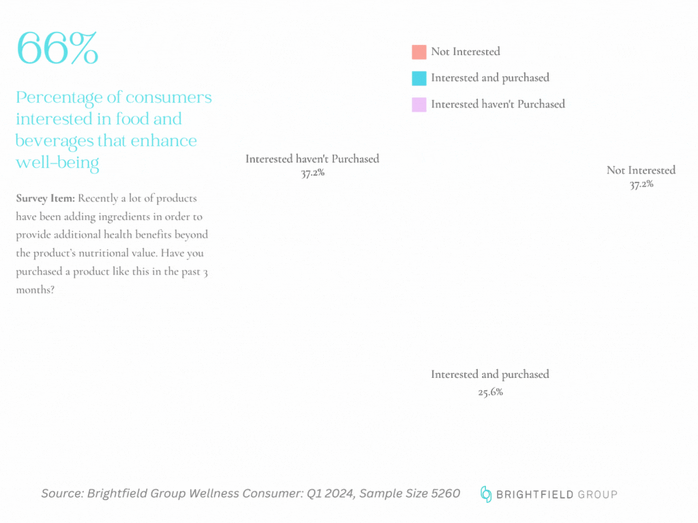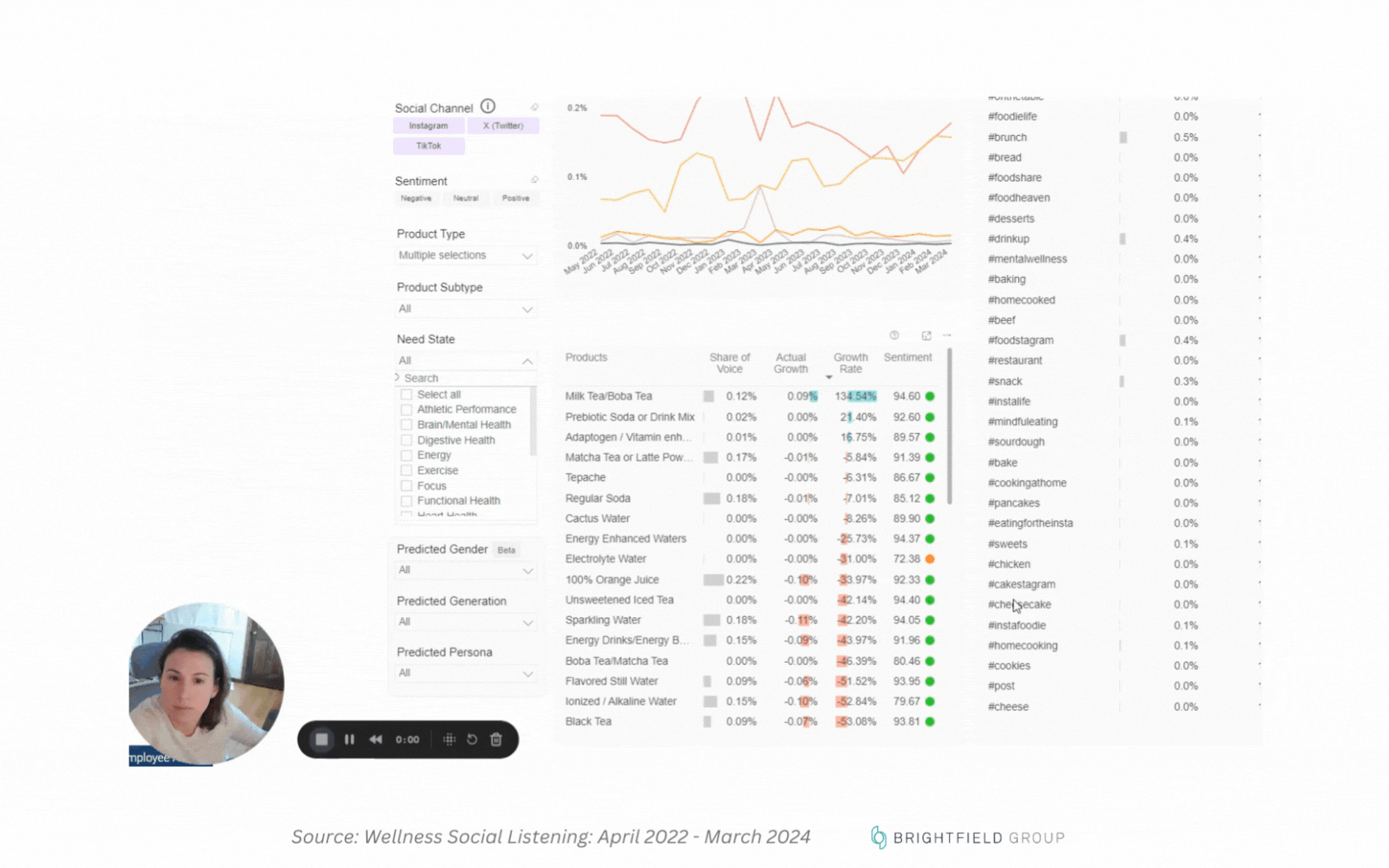A Paradox of Choice: Desire Outpaces Consumption
The functional beverage market presents a fascinating paradox. While overall consumption shows modest growth, there's a surge in consumer interest in these products. This trend is fueled by a growing emphasis on self-optimization across demographics. A staggering 66% of individuals now actively seek food and beverages that enhance their well-being, reflecting a cultural shift towards intentional living. These products are coveted for their potential to improve sleep, focus, energy levels, and overall mental and physical well-being.
Figure 1: Discerning Consumers Seek Targeted Benefits

Discerning Consumers Seek Targeted Benefits: A Shift Towards Moderation
Today's health-conscious consumer is more discerning than ever before, evident in a notable increase in self-reported need states for functional beverages. This translates to a shift in consumer priorities, moving beyond generic "wellness" and towards a holistic approach that integrates beverages into their daily routines for targeted optimization. Consumers are actively seeking out drinks that align with their specific goals, be it brain health, stress management, or enhanced physical performance.
However, a fascinating paradox emerges. While overall beverage purchase incidence might show negative growth, particularly for older demographics, there's a surge in consumer interest in these products. This suggests consumers may need a push out of their curiosity into action. It also hints as a trend towards moderation - consumers might be opting for these beverages less frequently than traditional options, but when they do consume, they're seeking products with specific functional benefits.
Capitalizing on Need States: Persona-Driven Innovation
This disconnect presents an opportunity for brands to bridge the gap between interest and purchase. Brands like Aspire and Recess exemplify how to capitalize on this trend by appealing to multiple persona segments through different lenses of need states, ingredients and categories.
- Aspire: Targeting individuals seeking enhanced energy and focus, Aspire leverages natural ingredients like green tea extract, guarana, and L-carnitine. This resonates with consumers who want to optimize their cognitive performance without the drawbacks of sugary or overly caffeinated and thus jittery drinks.
- Recess: A Multifaceted Approach to Well-being Recess takes a multi-faceted approach to catering to the "not tired, not wired" consumer seeking moments of calm amidst a busy world. Their mantra "calm, cool, collected" perfectly captures this essence. Their diverse product line offers options for various needs.
By offering targeted solutions across various need states, these brands demonstrate how functional beverages can be integrated into different aspects of a consumer's daily routine and appeal to multiple persona segments. Whether it’s:
.png?width=284&height=284&name=Copy%20of%20Your%20paragraph%20text%20(3).png)
- Linda, a 65-year-old retiree, that values functional beverages for their ability to support an active, health-focused lifestyle embarking on a cross-country flight to visit her grandchildren. Linda reaches for a natural energy drink at the airport after her flight so she can stay energetic and alert, allowing her to keep pace with her active grandkids throughout the visit.
- Or Lucas, a 34-year-old software engineer who enters intense flow states but has trouble disconnecting at the end of his workday. Lucas seeks a beverage with calming effects towards the end of his day so he can disconnect and still be present with his wife. For Lucas, this choice reflects a lifestyle decision aimed at managing stress and maintaining balance in a demanding world.
Economic Factors and the Rise of Moderation
Economic factors undoubtedly contribute to the trend of moderation. Modest growth in overall consumption suggests that economic challenges might influence purchasing decisions. Additionally, Brightfield Group's data reveals that only 26% of consumers are currently driving market trends with their purchases. However, a substantial 37% segment demonstrates interest without subsequent purchase action. This discrepancy highlights the untapped potential within the functional beverage sector. Among these, we see that Gen Z and Millennials constitute the bulk of this burgeoning market, with Millennials making up 46.5% and Gen Z accounting for 10.1%. Moreover, trends show that Gen X is an active participant, with 25.6% showing interest and purchase behavior. These groups, along with personas like "Trendy Enthusiasts" and "Wellness Seekers," present a ripe opportunity for brands to convert curiosity into sales.
The Rise of Moderation and Shift in Conversation
Social listening data further reinforces the economic influences at play. While conversations surrounding enhanced beverage categories like sports drinks, energy drinks, and kombucha are stagnating, there's a distinct uptick when discussions shift towards brain and mental health, energy, and focus. This growth is particularly noticeable across categories like alkaline water, coconut water, HMB water, and tea.

Gen Z's noted decrease in alcohol consumption, with only 11% driving the functional beverage market according to Brightfield data, could also be contributing to this trend. This health-conscious generation might be turning to functional beverages as a healthier and potentially more cost-effective alternative.
These trends suggest a potential twofold shift in consumer behavior:
- A move towards moderation: Consumers might be opting for these beverages less frequently than traditional options, but when they do consume, they're seeking products with specific functional benefits.
- A focus on specific functionalities: The conversation is moving beyond generic "wellness" and towards drinks that address targeted needs like improved cognitive performance, stress management, or overall well-being.
Bridging the Gap: Communication and Strategic Innovation
Therefore, as brands navigate this landscape, it is essential to not only innovate but also communicate effectively, addressing the gap between interest and purchase, and ensuring that products are visible, accessible, and resonate with the specific needs and aspirations of the wellness-oriented consumer. This can involve:
- Targeted messaging: Tailoring communication to address the "need states" and goals of different consumer personas.
- Ingredient transparency: Highlighting high-quality, functional ingredients that cater to specific needs.
- Innovation that goes beyond the generic: Developing unique and targeted beverage solutions that address specific concerns like cognitive performance or stress management.
- Omnichannel marketing: Reaching consumers across various touchpoints to educate and build brand loyalty.
By implementing these strategies, brands can bridge the gap between consumer interest and purchase intent, turning this fascinating paradox of desire and moderation into a thriving market opportunity.
Brightfield: Unlocking Market Dynamics
At Brightfield, we leverage advanced analytics and robust consumer insights to empower brands to effectively capitalize on these emerging trends.
Updated: 4/26/2024


.png?width=332&height=332&name=Copy%20of%20Your%20paragraph%20text%20(1).png)

